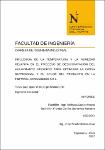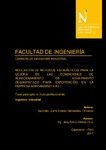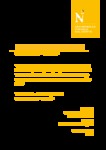| dc.contributor.advisor | Oblitas Cruz, Jimy Frank | |
| dc.contributor.author | Aurazo Hoyos, Ingri Melissa | |
| dc.contributor.author | Barrantes Navarro, Fiorela Cecilia | |
| dc.date.accessioned | 2017-11-29T20:57:23Z | |
| dc.date.available | 2017-11-29T20:57:23Z | |
| dc.date.issued | 2017-10-30 | |
| dc.identifier.citation | Aurazo, I. M., & Barrantes, F. C. (2017). Influencia de la temperatura y la humedad relativa en el proceso de deshidratación del aguaymanto orgánico para optimizar la carga nutricional y el color del producto en la empresa Agroandino S.R.L. (Tesis de licenciatura). Repositorio de la Universidad Privada del Norte. Recuperado de http://hdl.handle.net/11537/12355 | es_PE |
| dc.identifier.other | 670.42 AURA 2017 | es_PE |
| dc.identifier.uri | https://hdl.handle.net/11537/12355 | |
| dc.description.abstract | RESUMEN
La presente investigación se realizó en la empresa AgroAndino S.R.L. perteneciente al sector
productivo, esta se dedica a la deshidratación de fruta, siendo su principal producto el aguaymanto
deshidratado orgánico, su principal problema es el cambio de color del producto ya que la empresa
oferta un “Golden Berry” deshidratado de color amarillo naranja pero muchas veces toma un color
marrón, generando problemas en la imagen y calidad de producto, por otra parte como la empresa está
en crecimiento requiere la adquisición de un nuevo horno con las condiciones idóneas para la utilización
de la tecnología incrementado así sus ventas; de allí que el propósito de la presente investigación
consistió en determinar la influencia de la temperatura y humedad relativa en el proceso de
deshidratación del aguaymanto orgánico para optimizar la carga nutricional y el color del producto en
la empresa AgroAndino S.R.L., teniendo como hipótesis que mediante la influencia de l a temperatura
y la humedad relativa en proceso de deshidratación del aguaymanto orgánico el valor nutricional
aumentará y el color marrón cambiará a amarillo naranja. El estudio se realizó mediante pruebas de
secado, análisis físico – químicos y la recolección de información a través de entrevistas, análisis
documental, guía de observación y toma de datos. Se midió la carga nutricional mediante la
cuantificación de la vitamina C y el color del producto en términos de L*, a*, b* (luminosidad, matiz y
saturación). La información obtenida se procesó en Excel y se realizó un modelamiento de superficie
de respuesta mediante el Software Statgrafic consolidando los resultados en tablas y figuras, también
se desarrolló una evaluación económica mediante la metodología costo – beneficio. De acuerdo a los
resultados para la vitamina C, la temperatura influye significativamente en su optimización con un valor
– P menor de 0.05 y un R
2
de 99.9989%, en cuanto al color para los indicadores L* y b*, la temperatura
y la humedad relativa influyen significativamente con un valor - P menor de 0.05 y un R
de 99.7826%
para L* y 99.9724% para b*, en cuanto al indicador a*, sólo la temperatura presenta un valor-P menor
de 0.05 con un R
2
de 97.5471%. Se determinó que la temperatura de deshidratación óptima para lograr
una menor perdida de vitamina C es de 63.23ºC. Para que el aguaymanto deshidratado tenga un color
más claro la temperatura tiene que ser de 60 °C y llegar una humedad relativa de 40% y si se desea
obtener un aguaymanto deshidratado más amarillo la temperatura debe ser de 66.78ºC. En cuanto a
la evaluación económica, se obtuvo un VAN de 150 532.70 soles, con un TIR de 185% y por cada sol
de inversión retorna 4.74 soles de rentabilidad. Y finalmente se obtuvo un CPPC de 18.69%,
concluyendo que el proyecto es viable. Para la aplicación de esta investigación se tiene que tener la
debida disponibilidad de laboratorio y los equipos, tomar datos más acercados a la realidad para
obtener resultados óptimos.
PALABRAS CLAVE: carga nutricional, color del producto, curvas de secado, superficie de respuesta,
CIELAB. | es_PE |
| dc.description.abstract | ABSTRACT
The present investigation was carried out in the company AgroAndino S.R.L. Pertaining to the productive
sector, this one is dedicated to the dehydration of fruit, being its main product the organic dehydrated
aguaymanto, its main problem is the color change of the product since the company offers a "Golden
Berry" dehydrated of yellow orange color but many Sometimes takes a brown color, generating problems
in the image and quality of product, on the other hand as the company is in growth requires the
acquisition of a new furnace with the ideal conditions for the use of the technology thus increased its
sales; The purpose of the present investigation was to determine the influence of temperature and
relative humidity in the process of dehydration of the organic aguaymanto to optimize the nutritional load
and the color of the product in the company AgroAndino SRL, having as hypothesis that Influence of
temperature and relative humidity in dehydration process of the organic aguaymanto the nutritional value
will increase and the brown color will change to yellow orange. The study was performed through drying
tests, physical - chemical analysis and the collection of information through interviews, documentary
analysis, observation guide and data collection. The nutritional load was measured by quantifying
vitamin C and product color in terms of L *, a *, b * (brightness, hue and saturation). The information
obtained was processed in Excel and a response surface modeling was performed using the Statgrafic
Software, consolidating the results into tables and figures. An economic evaluation was also developed
using the cost - benefit methodology. According to the results for vitamin C, the temperature significantly
influences its optimization with a P-value less than 0.05 and an R2 of 99.9989%, as regards color for
the L * and b * indicators, temperature and relative humidity Have a significant P-value of less than 0.05
and an R2 of 99.7826% for L * and 99.9724% for b *, as for indicator a *, only the temperature has a Pvalue
of less than 0.05 with an R2 of 97.5471% . It was determined that the optimum dehydration
temperature to achieve a lower vitamin C loss is 63.23 ° C. In order for the dehydrated aguaymanto to
have a lighter color the temperature must be 60 ° C and a relative humidity of 40% and if it is desired to
obtain a dehydrated aguaymanto plus yellow the temperature must be 66.78 ° C. As for the economic
evaluation, a NPV of 150 532.70 soles was obtained, with a TIR of 185% and for each investment sol
returns 4.74 soles of profitability. And finally a CPPC of 18.69% was obtained, concluding that the project
is viable. For the application of this research has to have the proper availability of laboratory and
equipment, take data closer to reality for optimal results.
KEYWORDS: nutritional load, product color, drying curves, response surface, CIELAB. | es_PE |
| dc.description.uri | Tesis | es_PE |
| dc.format | application/pdf | es_PE |
| dc.format | application/msword | es_PE |
| dc.language.iso | spa | es_PE |
| dc.publisher | Universidad Privada del Norte | es_PE |
| dc.rights | info:eu-repo/semantics/openAccess | es_PE |
| dc.rights | Atribución-NoComercial-CompartirIgual 3.0 Estados Unidos de América | es_PE |
| dc.rights.uri | https://creativecommons.org/licenses/by-nc-sa/3.0/us/ | * |
| dc.source | Universidad Privada del Norte | es_PE |
| dc.source | Repositorio Institucional - UPN | es_PE |
| dc.subject | Temperatura | es_PE |
| dc.subject | Productos | es_PE |
| dc.subject | Deshidratación de alimentos | es_PE |
| dc.title | Influencia de la temperatura y la humedad relativa en el proceso de deshidratación del aguaymanto orgánico para optimizar la carga nutricional y el color del producto en la empresa Agroandino S.R.L. | es_PE |
| dc.type | info:eu-repo/semantics/bachelorThesis | es_PE |
| thesis.degree.grantor | Universidad Privada del Norte. Facultad de Ingeniería | es_PE |
| thesis.degree.level | Título Profesional | es_PE |
| thesis.degree.discipline | Ingeniería Industrial | es_PE |
| thesis.degree.name | Ingeniero Industrial | es_PE |
| dc.publisher.country | PE | es_PE |
| dc.subject.ocde | https://purl.org/pe-repo/ocde/ford#2.11.04 | es_PE |
| thesis.degree.program | Pregrado | es_PE |
| dc.description.sede | Cajamarca | es_PE |
| renati.advisor.dni | 40043738 | |
| renati.author.dni | 72202923 | |
| renati.author.dni | 70753575 | |
| renati.discipline | 722026 | es_PE |
| renati.level | https://purl.org/pe-repo/renati/level#tituloProfesional | es_PE |
| renati.type | https://purl.org/pe-repo/renati/type#tesis | es_PE |








